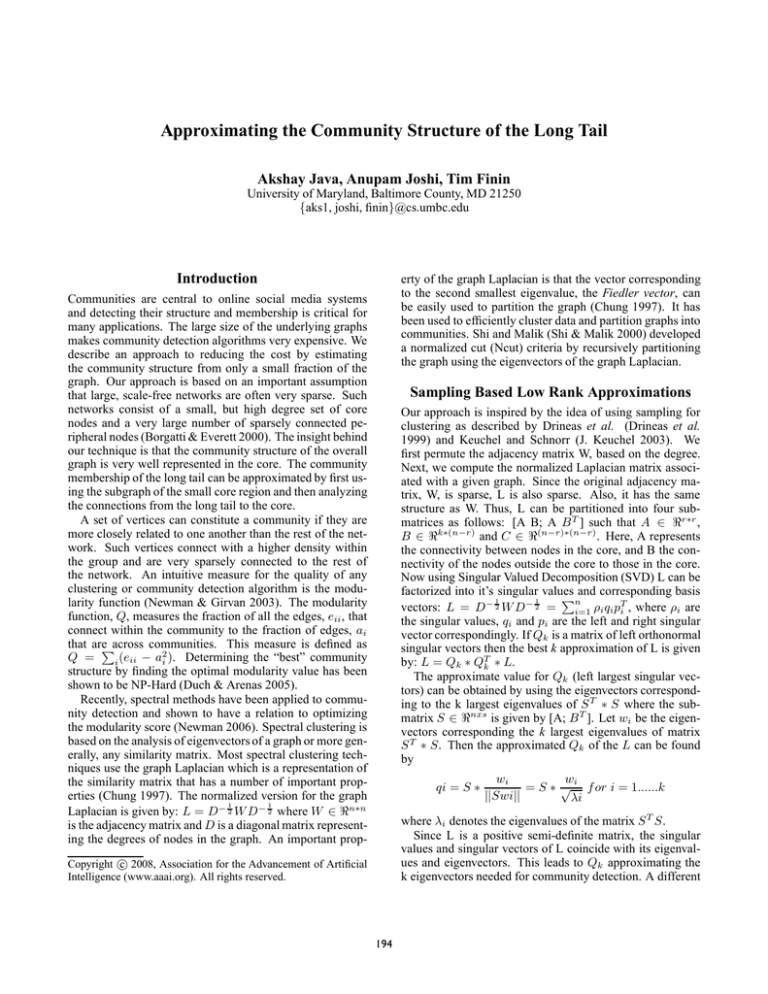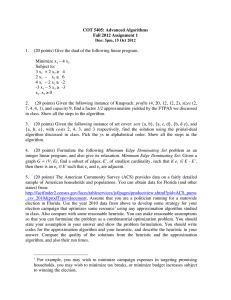
Approximating the Community Structure of the Long Tail
Akshay Java, Anupam Joshi, Tim Finin
University of Maryland, Baltimore County, MD 21250
{aks1, joshi, finin}@cs.umbc.edu
Introduction
erty of the graph Laplacian is that the vector corresponding
to the second smallest eigenvalue, the Fiedler vector, can
be easily used to partition the graph (Chung 1997). It has
been used to efficiently cluster data and partition graphs into
communities. Shi and Malik (Shi & Malik 2000) developed
a normalized cut (Ncut) criteria by recursively partitioning
the graph using the eigenvectors of the graph Laplacian.
Communities are central to online social media systems
and detecting their structure and membership is critical for
many applications. The large size of the underlying graphs
makes community detection algorithms very expensive. We
describe an approach to reducing the cost by estimating
the community structure from only a small fraction of the
graph. Our approach is based on an important assumption
that large, scale-free networks are often very sparse. Such
networks consist of a small, but high degree set of core
nodes and a very large number of sparsely connected peripheral nodes (Borgatti & Everett 2000). The insight behind
our technique is that the community structure of the overall
graph is very well represented in the core. The community
membership of the long tail can be approximated by first using the subgraph of the small core region and then analyzing
the connections from the long tail to the core.
A set of vertices can constitute a community if they are
more closely related to one another than the rest of the network. Such vertices connect with a higher density within
the group and are very sparsely connected to the rest of
the network. An intuitive measure for the quality of any
clustering or community detection algorithm is the modularity function (Newman & Girvan 2003). The modularity
function, Q, measures the fraction of all the edges, eii , that
connect within the community to the fraction of edges, ai
that arePacross communities. This measure is defined as
2
Q =
i (eii − ai ). Determining the “best” community
structure by finding the optimal modularity value has been
shown to be NP-Hard (Duch & Arenas 2005).
Recently, spectral methods have been applied to community detection and shown to have a relation to optimizing
the modularity score (Newman 2006). Spectral clustering is
based on the analysis of eigenvectors of a graph or more generally, any similarity matrix. Most spectral clustering techniques use the graph Laplacian which is a representation of
the similarity matrix that has a number of important properties (Chung 1997). The normalized version for the graph
1
1
Laplacian is given by: L = D− 2 W D− 2 where W ∈ ℜn∗n
is the adjacency matrix and D is a diagonal matrix representing the degrees of nodes in the graph. An important prop-
Sampling Based Low Rank Approximations
Our approach is inspired by the idea of using sampling for
clustering as described by Drineas et al. (Drineas et al.
1999) and Keuchel and Schnorr (J. Keuchel 2003). We
first permute the adjacency matrix W, based on the degree.
Next, we compute the normalized Laplacian matrix associated with a given graph. Since the original adjacency matrix, W, is sparse, L is also sparse. Also, it has the same
structure as W. Thus, L can be partitioned into four submatrices as follows: [A B; A B T ] such that A ∈ ℜr∗r ,
B ∈ ℜk∗(n−r) and C ∈ ℜ(n−r)∗(n−r) . Here, A represents
the connectivity between nodes in the core, and B the connectivity of the nodes outside the core to those in the core.
Now using Singular Valued Decomposition (SVD) L can be
factorized into it’s singular values and corresponding basis
Pn
1
1
vectors: L = D− 2 W D− 2 = i=1 ρi qi pTi , where ρi are
the singular values, qi and pi are the left and right singular
vector correspondingly. If Qk is a matrix of left orthonormal
singular vectors then the best k approximation of L is given
by: L = Qk ∗ QTk ∗ L.
The approximate value for Qk (left largest singular vectors) can be obtained by using the eigenvectors corresponding to the k largest eigenvalues of S T ∗ S where the submatrix S ∈ ℜnxs is given by [A; B T ]. Let wi be the eigenvectors corresponding the k largest eigenvalues of matrix
S T ∗ S. Then the approximated Qk of the L can be found
by
qi = S ∗
wi
wi
= S ∗ √ f or i = 1......k
||Swi||
λi
where λi denotes the eigenvalues of the matrix S T S.
Since L is a positive semi-definite matrix, the singular
values and singular vectors of L coincide with its eigenvalues and eigenvectors. This leads to Qk approximating the
k eigenvectors needed for community detection. A different
c 2008, Association for the Advancement of Artificial
Copyright Intelligence (www.aaai.org). All rights reserved.
194
interpretation of this approach is in terms of the Nyström
method.
Mean Computation Time
Mean Modularity Scores
3.5
0.7
SVD
Approximation
Heuristic
Ncut
0.6
2.5
We propose another approach that uses the structure of the
blogs graph directly. We use the head of the distribution to
first find the communities in the graph. The intuition is that
communities might form around popular nodes. So we can
use Ncut (or any of the community detection algorithms) to
find the initial communities in a graph that is much smaller
than the original one. This leaves the problem of finding
the community of the blogs that are not a part of the head.
One simple, yet effective heuristic is to look at the number of links from a blog to each community as identified
from the clustering of the nodes in the head, and declare it
to be a member of the community that it most associates
with by this measure. This heuristic can significantly reduce
the computation time, while providing a reasonable approximation to the community structure that would be found by
running the same Ncut algorithm over the entire graph.
4000
5000
2000
3000
nz = 51537
4000
5000
0
1000
2000
3000
4000
nz = 51537
50%
0
10%
20%
30%
40%
50%
Columns Sampled
References
3000
1000
40%
Borgatti, S. P., and Everett, M. G. 2000. Models of core/periphery
structures. Social Networks 21(4):375–395.
Chung, F. R. K. 1997. Spectral Graph Theory (CBMS Regional
Conference Series in Mathematics, No. 92) (Cbms Regional Conference Series in Mathematics). American Mathematical Society.
Drineas; Frieze; Kannan; Vempala; and Vinay. 1999. Clustering
in large graphs and matrices. In SODA: ACM-SIAM Symposium
on Discrete Algorithms (A Conference on Theoretical and Experimental Analysis of Discrete Algorithms).
Duch, J., and Arenas, A. 2005. Community detection in complex networks using extremal optimization. Physical Review E
72:027104.
Fowlkes, C.; Belongie, S.; Chung, F.; and Malik, J. 2004. Spectral
grouping using the nyström method. IEEE Trans. Pattern Anal.
Mach. Intell. 26(2):214–225.
J. Keuchel, C. S. 2003. Efficient graph cuts for unsupervised
image segmentation. using probabilistic sampling and svd-based
approximation.
Newman, M. E. J., and Girvan, M. 2003. Finding and evaluating
community structure in networks.
Newman, M. E. J. 2006. Finding community structure in networks using the eigenvectors of matrices. Physical Review E
74:036104.
Shi, J., and Malik, J. 2000. Normalized cuts and image segmentation. IEEE Transactions on Pattern Analysis and Machine
Intelligence 22(8):888–905.
BT
0
30%
Conclusions
2000
5000
20%
In this work, we present approximate methods for community detection in large graphs. It has the advantage of quickly
and efficiently finding a reasonable approximation to the
community structure of the overall network. We also present
an intuitive heuristic and show that it results in good performance at a much lower costs.
2000
C
10%
In terms of running time the complexity of Ncut is O(nk)
where n is the number of nodes in the graph and k is the
number of communities. Thus the heuristic is O(rk) where
r is the number nodes in the head. On the other hand, the
complexity of low rank SVD is O(nk 2 ) where the original
graph is approximated by its rank k basis vectors. Finally the
sub-sampling based approximation can be efficiently implemented in O(r3 ) using the Nyström Method (Fowlkes et al.
2004).
1000
4000
0.5
for different sampling rates (10% to 50%) over 100 runs. Bars
are in the following order: SVD, Sampling Based Approximation,
Heuristic, Ncut.
0
3000
1
0.1
Figure 2: Modularity scores (left) and computation times (right)
0
1000
0.2
Columns Sampled
In order to evaluate the quality of approximation we use a
blog graph consisting of six thousand nodes. Figure 1 shows
the original sparse matrix permuted using the degree of the
node to reveal the core-periphery structure of the graph also
shows the communities detected using the heuristic method.
Since there is no ground truth available, we use the modularity score, Q, as a measure of quality for the resulting communities found by each of the methods. We also compare the
approximate methods with Ncut algorithm. Another possible way to approximately calculate communities would be
to cluster the singular vectors U obtained using the low-rank
approximations of the original large, sparse matrix W.
Figure 2 shows the performance of Ncut, low-rank SVD,
approximation method and heuristic method for computing
the communities. The results indicate that both the approximation and heuristic method provide high modularity scores
even at low sampling rates (10%-50%). Also, the time required to compute the communities is comparable or at times
less than that of using Ncut. In addition the memory requirements are much less since only a small fraction of the entire
graph is sampled.
B
1.5
0.3
0
Evaluation
A
2
0.4
Secs
Modularity
0.5
Heuristic Based Approximation Method
SVD
Approximation
Heuristic
Ncut
3
5000
Figure 1: A Webgraph consisting of 6000 blogs (left) is sampled at
30% using the heuristic method. The resulting communities identified are shown on the right. The modularity score was found to
be about 0.5 using 20 communities.
195





